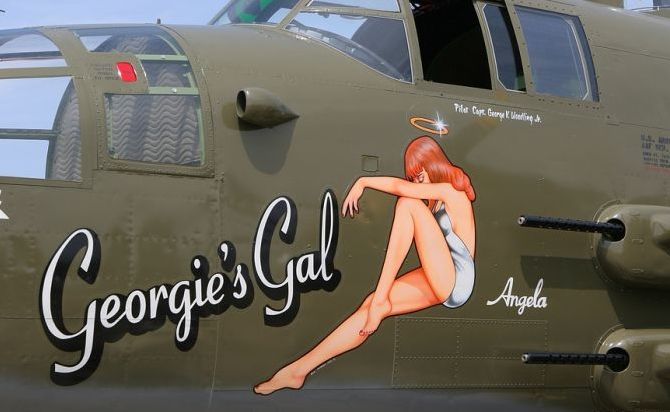|
|
Nose Art Painting Of A Military Aircraft
|
Some nose art was commemorative or intended to honor certain people such as the B-29 Superfortress, "The Ernie Pyle".
The work was done by professional civilian artists as well as talented amateur servicemen. In 1941, for instance, the 39th Pursuit Squadron commissioned a Bell Aircraft artist to design and paint the "Cobra in the Clouds" logo on their aircraft. Perhaps the most enduring nose art of WWII was the shark-face motif, which first appeared on the Bf-110s of Luftwaffe 76th Destroyer Wing over Crete, where the twin-engined Messerschmitts outmatched the Gloster Gladiator biplanes of RAF 112 Squadron. The Commonwealth pilots were withdrawn to Egypt and refitted with Curtiss Tomahawks off the same assembly line building fighter aircraft for the AVG Flying Tigers being recruited for service in China. In November 1941, AVG pilots saw a 112 Squadron Tomahawk in an illustrated weekly and immediately adopted the shark-face motif for their own planes. This work was done by the pilots and ground crew in the field. Similarly, when in 1943 the 39th Fighter Squadron became the first American squadron in their theatre with 100 kills, they adopted the shark-face for their P-38 Lightnings. The shark-face is still used to this day, most commonly seen on the A-10 Thunderbolt II (with its gaping maw leading up to the muzzle of the aircraft's GAU-8 Avenger 30mm cannon), especially those of the 23d Fighter Group, the AVG's descendent unit, and a testament to its popularity as a form of nose art.
The largest known work of nose art ever depicted on a WW II-era American combat aircraft was on a B-24J Liberator, s/n 44-40973, which had been named "The Dragon and his Tail" of the USAAF's Fifth Air Force's 64th Bomb Squadron, 43d Bomb Group, in the Southwest Pacific, flown by a crew led by Joseph Pagoni, with Staff Sergeant Sarkis Bartigan as the artist. The dragon artwork ran from the nose just forward of the cockpit, down the entire length of the fuselage's sides, with the dragon's body depicted directly below and just aft of the cockpit, with the dragon holding a nude woman in its forefeet.
Tony Starcer was the resident artist for the 91st Bomb Group (Heavy), one of the initial six groups fielded by the Eighth Air Force. Starcer painted over a hundred pieces of renowned B-17 nose art, including "Memphis Belle". A commercial artist named Brinkman, from Chicago, was responsible for the zodiac-themed nose art of the B-24 Liberator-equipped 834th Bomb Squadron, based at RAF Sudbury, England.
|
|









